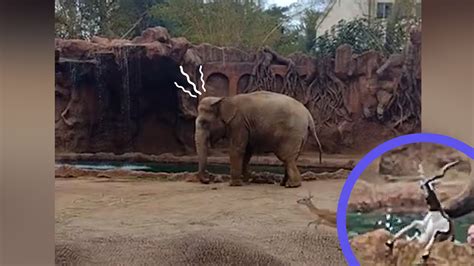
An elephant in Kruger National Park, South Africa, has been observed rescuing an antelope from drowning in a watering hole, showcasing an act of interspecies compassion that has captivated viewers worldwide. The extraordinary event, captured on video, highlights the complex social behavior and potential for empathy in elephants, sparking discussions about animal cognition and altruism.
A dramatic scene unfolded at a watering hole in Kruger National Park when an antelope found itself struggling to stay afloat. Seemingly helpless, the antelope’s plight caught the attention of an elephant nearby. In an unexpected display of compassion, the elephant extended its trunk and carefully guided the distressed antelope to the safety of the shore. The video, which quickly went viral, has sparked widespread admiration and renewed interest in the emotional intelligence of elephants.
The incident, which occurred recently, was filmed by tourists visiting the park. According to reports, the antelope had ventured too far into the watering hole and was unable to regain its footing. As it struggled, the elephant approached the water’s edge. Witnesses described the elephant as initially hesitant, as if assessing the situation. Then, with a deliberate movement, it reached out with its trunk and gently nudged the antelope towards shallower water.
“It was incredible to watch,” said one of the tourists who captured the footage. “The elephant seemed to understand exactly what was happening and knew how to help. It was a truly remarkable display of empathy.”
The video shows the elephant carefully maneuvering the antelope until it was able to stand on solid ground. Once the antelope was safely ashore, the elephant appeared to observe it for a moment before returning to its herd. The rescued antelope, seemingly unharmed, quickly rejoined its own group.
This act of apparent altruism has generated significant discussion among wildlife experts and animal behaviorists. While elephants are known for their intelligence and complex social structures, such direct intervention to aid another species is relatively rare. Some experts suggest that the elephant’s behavior could be attributed to learned social behavior within its herd or a general sense of empathy. Others propose that the elephant may have perceived the antelope’s distress as a potential disruption to the water source and acted to restore calm.
Regardless of the underlying motivation, the incident serves as a powerful reminder of the interconnectedness of wildlife and the potential for surprising displays of compassion in the natural world. The video has not only captured the hearts of viewers but has also provided valuable insight into the complex cognitive abilities of elephants.
The rescue highlights the ongoing debates regarding animal emotions and whether animals other than humans can exhibit true altruism. Altruism, in its purest form, involves selfless acts performed with no expectation of personal gain. While it is difficult to definitively determine the motivations behind animal behavior, observations like this one continue to challenge traditional views of animal cognition.
Elephants are known for their strong family bonds and cooperative behavior within their herds. They exhibit a wide range of emotions, including grief, joy, and compassion. There have been documented cases of elephants caring for injured or orphaned members of their herd, demonstrating a capacity for empathy and social support.
However, instances of elephants directly assisting animals of other species are less common. This particular event has drawn comparisons to other reported cases of interspecies altruism, such as dolphins helping humans or primates adopting orphaned animals of different species. These incidents raise profound questions about the nature of animal consciousness and the potential for cross-species understanding.
The Kruger National Park, where the rescue occurred, is one of the largest game reserves in Africa, covering an area of over 19,000 square kilometers (7,336 square miles). It is home to a vast array of wildlife, including elephants, lions, leopards, rhinoceroses, buffalos, and numerous species of birds and reptiles. The park attracts millions of visitors each year, who come to witness the incredible biodiversity and natural beauty of the African bush.
Park officials have praised the elephant’s actions and emphasized the importance of preserving such natural habitats. They noted that the incident underscores the delicate balance of the ecosystem and the need to protect wildlife from human encroachment and other threats.
The viral video has sparked numerous discussions on social media, with users expressing admiration for the elephant’s compassion and calling for greater efforts to protect these intelligent and sensitive animals. Many have also highlighted the importance of supporting conservation efforts and responsible tourism in order to ensure the survival of elephants and other endangered species.
The incident serves as a powerful reminder of the ethical considerations surrounding human interactions with animals. It challenges us to reconsider our assumptions about animal intelligence and to recognize the inherent worth of all living creatures. By promoting respect and understanding, we can foster a more harmonious relationship between humans and the natural world.
The rescue also has broader implications for our understanding of animal behavior and the potential for conservation. Further research into elephant cognition and social dynamics could provide valuable insights into how we can better protect these magnificent creatures and their habitats. By learning more about the complex lives of elephants, we can develop more effective conservation strategies and promote a more sustainable future for both humans and wildlife.
The incident in Kruger National Park stands as a testament to the power of nature and the potential for unexpected acts of kindness. It reminds us that compassion is not limited to humans and that even the largest of creatures can exhibit the most tender of hearts. The elephant’s heroic rescue of the antelope will undoubtedly remain a memorable and inspiring story for years to come.
The story has also prompted discussions about the potential for anthropomorphism in interpreting animal behavior. Anthropomorphism is the attribution of human traits, emotions, or intentions to non-human entities. While it is important to avoid overly simplistic or romanticized views of animal behavior, it is also crucial to recognize the growing body of evidence that suggests animals are capable of complex emotions and cognitive processes.
Scientists are increasingly using sophisticated research methods to study animal cognition, including observational studies, experimental manipulations, and brain imaging techniques. These studies have revealed that many animals, including elephants, possess remarkable abilities, such as problem-solving skills, self-awareness, and the capacity for empathy.
The elephant’s rescue of the antelope may be seen as an example of what is sometimes referred to as “emotional contagion,” where an animal experiences a similar emotion to another animal and is motivated to help alleviate the distress. Alternatively, the elephant may have recognized that the antelope was in danger and acted out of a learned response, having observed similar situations in the past.
Whatever the underlying motivation, the elephant’s behavior underscores the complexity of animal social dynamics and the potential for interspecies cooperation. It challenges us to move beyond traditional anthropocentric views of the world and to recognize the inherent value and dignity of all living creatures.
In the context of conservation, the story highlights the importance of protecting not only individual species but also the complex ecological relationships that exist within ecosystems. Elephants play a crucial role in maintaining the health and biodiversity of their habitats. They help to disperse seeds, create pathways for other animals, and modify vegetation patterns. By protecting elephants and their habitats, we are also protecting a wide range of other species that depend on these ecosystems for survival.
The ongoing threats to elephant populations, including poaching, habitat loss, and human-wildlife conflict, make it all the more important to promote conservation efforts and raise awareness about the plight of these magnificent animals. The story of the elephant’s rescue serves as a powerful reminder of what is at stake and the urgent need to protect elephants for future generations.
The event also showcases the potential for positive interactions between humans and wildlife. The tourists who filmed the rescue played a valuable role in documenting this extraordinary event and sharing it with the world. By promoting responsible tourism and educating the public about wildlife conservation, we can foster a greater appreciation for the natural world and encourage behaviors that support the well-being of animals.
In conclusion, the elephant’s heroic rescue of the antelope in Kruger National Park is a remarkable story that has captured the hearts of viewers worldwide. It highlights the complex social behavior and potential for empathy in elephants, sparking discussions about animal cognition, altruism, and the importance of conservation. The incident serves as a powerful reminder of the interconnectedness of wildlife and the need to protect these magnificent creatures and their habitats for future generations. It also underscores the importance of responsible tourism and the potential for positive interactions between humans and wildlife. The event stands as a testament to the power of nature and the potential for unexpected acts of kindness, reminding us that compassion is not limited to humans and that even the largest of creatures can exhibit the most tender of hearts. As we continue to learn more about the complex lives of elephants and other animals, we can develop more effective conservation strategies and promote a more sustainable future for both humans and wildlife. The story of the elephant’s rescue will undoubtedly remain a memorable and inspiring story for years to come, encouraging us to reconsider our assumptions about animal intelligence and to recognize the inherent worth of all living creatures. It challenges us to move beyond traditional anthropocentric views of the world and to foster a more harmonious relationship between humans and the natural world.
The story also prompts consideration of the ethical implications of observing and documenting wildlife. While the tourists who filmed the rescue played a role in sharing this remarkable event, it is important to remember that their presence in the park may have had an impact on the animals’ behavior. Responsible tourism practices emphasize the importance of minimizing disturbance to wildlife and respecting their natural habitats. This includes maintaining a safe distance from animals, avoiding loud noises or sudden movements, and refraining from feeding or interacting with them in any way that could alter their behavior or disrupt their ecosystem. The incident serves as a reminder that our interactions with wildlife should always be guided by a sense of respect and responsibility, ensuring that we are not causing harm or disruption to their natural lives. The potential for human presence to affect animal behavior should be a constant consideration in wildlife observation and documentation.
Furthermore, the incident raises questions about the role of social media in shaping public perceptions of wildlife. The viral video of the elephant’s rescue has undoubtedly raised awareness about elephant conservation and the importance of protecting their habitats. However, it is also important to recognize that social media can sometimes present a romanticized or overly simplistic view of nature. It is crucial to supplement social media narratives with accurate information about the challenges facing elephants and other endangered species, as well as the complex ecological relationships that sustain their ecosystems. By promoting a more nuanced understanding of wildlife, we can encourage more informed and responsible attitudes towards conservation. The potential for social media to both inform and misinform about wildlife highlights the importance of critical thinking and media literacy in the digital age.
Finally, the elephant’s rescue of the antelope can be seen as a symbol of hope and resilience in a world that is facing numerous environmental challenges. The story reminds us that even in the face of adversity, acts of kindness and compassion are possible. It underscores the importance of fostering a sense of empathy and interconnectedness with all living creatures. By working together to protect our planet and its biodiversity, we can create a more sustainable and harmonious future for both humans and wildlife. The incident serves as a powerful reminder of the potential for positive change and the importance of remaining optimistic in the face of environmental challenges. It encourages us to embrace a more holistic and ethical approach to conservation, one that recognizes the inherent worth of all living creatures and the interconnectedness of all ecosystems. Frequently Asked Questions (FAQ)
1. What exactly happened in Kruger National Park?
An elephant was observed rescuing an antelope that was struggling to stay afloat in a watering hole. The elephant used its trunk to guide the antelope to safety on the shore. The incident was captured on video by tourists.
2. Has an elephant ever been reported of doing this before?
While elephants are known for their intelligence, empathy, and cooperative behavior within their herds, direct intervention to aid another species is relatively rare. There have been other reported cases of interspecies altruism from different animals, such as dolphins helping humans or primates adopting orphaned animals of different species. This incident has similarities to these events.
3. What motivated the elephant to help the antelope?
The exact motivation is unknown, but there are several possibilities. It could be due to learned social behavior within its herd, a general sense of empathy, or the elephant may have perceived the antelope’s distress as a potential disruption to the water source and acted to restore calm. The underlying motivation underscores the complexity of animal social dynamics and the potential for interspecies cooperation.
4. Where is Kruger National Park, and why is it significant?
Kruger National Park is one of the largest game reserves in Africa, located in South Africa. It covers over 19,000 square kilometers and is home to a vast array of wildlife, including elephants, lions, leopards, rhinoceroses, buffalos, and numerous species of birds and reptiles. The park attracts millions of visitors each year and is important for preserving African wildlife.
5. What are the conservation implications of this event?
The incident highlights the importance of protecting elephants and their habitats. Elephants play a crucial role in maintaining the health and biodiversity of their ecosystems. The ongoing threats to elephant populations, including poaching, habitat loss, and human-wildlife conflict, make it all the more important to promote conservation efforts and raise awareness about the plight of these animals.









